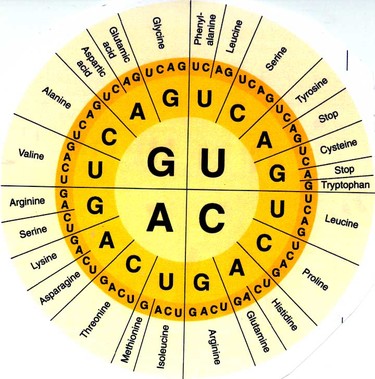The Genetic Code
The message in DNA comprises only three-letter words called codons. Each codon codes for an amino acid. There are 64 possible codons and 20 amino acids. Therefore, some codons code for the same amino acid.

The DNA codons are in a language that cannot be read by the protein-building machines called ribosomes. Ribosomes can only read RNA, so the message in DNA is converted to the language of messenger RNA (mRNA). The ribosome reads the mRNA codon by codon and builds a protein by binding amino acids.

Dog Riding A Tortis Section!!!!!

The mRNA Codon Chart
Below are two variations of the mRNA codon chart. Each codon chart shows the codon for each of the 20 amino acids.

Here is how to read the mRNA codon chart #1:
- The codon is AGC
- Start with the big A in the center of the chart.
- Move to the first outer layer and find the G.
- Move to the next outer layer and find the C.
- Follow the path from A to G to C to the outermost layer, and you will discover that the mRNA codon codes for the amino acid serine.

Here is how to read the mRNA codon chart #2
- The codon is AGC
- Start with the big A row in the column to the left (yellow in color)
- Find the G column at the top of the chart (green)
- Follow the G column downwards to the big A row (step 2)
- Find the row with a little C in the column to the right (highlighted in blue)
- Now combine the A row (purple), the G column (yellow), and the C row (highlighted in blue)
- You will discover that the mRNA codon codes for the amino acid serine.
Why did you show me both charts?
Well, the first codon chart is easier to use, but the second chart is more likely to show up on a standardized test – i.e., AP Biology exam.
So can I use either one?
Yep. Both charts will give you the same results, so use the one that makes the most sense to you.
Things to Know About the mRNA Codon Chart
- The codon AUG is the start codon because all mRNA molecules start with it. AUG codes for the amino acid methionine
- Some amino acids have multiple codons—for example, the codons CGU, CGC, CGG, and CGA code for arginine.
- There are three stop codons at the end of an mRNA molecule. The stop codons do not code for an amino acid because they tell the ribosome when to stop reading the mRNA. The stop codons are UGA, UAA, and UAG.
Anticodons
There are different types of RNA. mRNA carries the DNA message to ribosomes, and transfer RNA (tRNA) brings amino acids to ribosomes. tRNA molecules carry one amino acid, and have the complementary message to a specific codon, called an anticodon. For example, a tRNA molecule with the anticodon UAC will bond to the codon AUG on an mRNA at the ribosome.

Dog Riding a Dolphin Section!!!!!

Transcription: DNA to mRNA
Just like dragons, DNA is too large and too important to leave the safety of the nucleus. A gene’s code in the language of DNA is transcribed into the language of RNA.
Here are the steps to transcription:
- RNA polymerase unzips the DNA.
- RNA polymerase builds messenger RNA (mRNA) by adding complementary bases to the DNA strand.
- The newly transcribed piece strand of RNA leaves the nucleus.

Translation: mRNA to Protein
Protein synthesis happens in the ribosomes, which live in the cytoplasm. The ribosome translates the mRNA and uses the information to build a protein.
Here are the steps to translation:
- mRNA binds to a ribosome.
- The tRNA molecules bring amino acids to the ribosome.
- The tRNA molecules’ anticodon binds to the complementary mRNA codon.
- The tRNA molecules release their amino acids, and the ribosome binds them.
- Steps 2-4 repeat until the entire mRNA is translated, which results in a protein.

Protein Synthesis
Protein synthesis comprises transcription (DNA to mRNA) and translation (mRNA to protein). Once protein synthesis is complete, the amino acid chain folds into a protein and is packaged for use by the cell or another part of the body.
Protein synthesis occurs in every living organism.
Even my best hamster Fluffy Flufferton Flufftastic IV?
Yep.
What about bacteria?
Yep. All living things need to make proteins, including hamsters, bacteria, and level 83 dragons.

